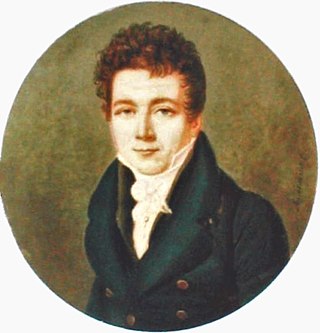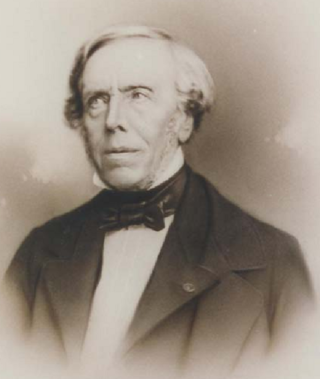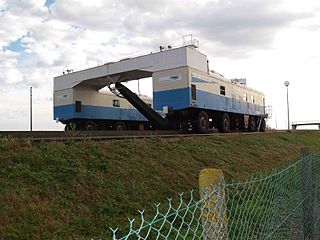
École des Ponts ParisTech is a university-level institution of higher education and research in the field of science, engineering and technology. Founded in 1747 by Daniel-Charles Trudaine, it is one of the oldest and one of the most prestigious French Grandes Écoles.

A grande école is a specialized institution of higher learning in France. Grandes Écoles, which are part of an alternative educational system that operates alongside the mainstream French public university system, are dedicated to teaching, research and professional training in single academic fields such as engineering, architecture, business administration, academic research, or public policy and administration.

Pierre-Simon Girard was a French mathematician and engineer, who worked on fluid mechanics.

Claude-Louis Navier was a French mechanical engineer, affiliated with the French government, and a physicist who specialized in continuum mechanics.

Louis Vicat was a French engineer.
ParisTech is a cluster that brings together 7 renowned grandes écoles based in Paris, France. It covers the whole spectrum of science, technology and management and has more than 12.000 students.

Jean-Baptiste Charles Joseph Bélanger was a French applied mathematician who worked in the areas of hydraulics and hydrodynamics. He was a professor at the École Centrale des Arts et Manufactures, École Polytechnique and École des Ponts et Chaussées in France. In hydraulic engineering, he is often credited improperly for the application of the momentum principle to a hydraulic jump in a rectangular open channel in 1828. His true contribution in 1828 was the development of the backwater equation for gradually varied flows in open channels and the application of the momentum principle to the hydraulic jump flow in 1838.

Jean-Rodolphe Perronet was a French architect and structural engineer, known for his many stone arch bridges. His best known work is the Pont de la Concorde (1787).

The École d'architecture de la ville et des territoires Paris-Est, Éav&t for short, is a fully accredited state-financed architecture school located in the east of Paris, France.
The Commission des Sciences et des Arts was a French scientific and artistic institute. Established on 16 March 1798, it consisted of 167 members, of which all but 16 joined Napoleon Bonaparte's conquest of Egypt and produced the Description de l'Égypte. More than half were engineers and technicians, including 21 mathematicians, 3 astronomers, 17 civil engineers, 13 naturalists and mining engineers, geographers, 3 gunpowder engineers, 4 architects, 8 artists, 10 mechanical artists, 1 sculptor, 15 interpreters, 10 men of letters, 22 printers in Latin, Greek and Arabic characters. Bonaparte organised his scientific 'corps' like an army, dividing its members into 5 categories and assigning to each member a military rank and a defined military role beyond his scientific function.

Jean Aubert was a French engineer. In 1961 he used the idea of the German engineer Julius Greve from the last century to describe a pente d'eau, which was a way of moving boats up the gradient of a canal without locks. The design consisted of a sloping channel through which a wedge of water on which the boat was floating could be pushed up an incline. This concept was used in both the Montech water slope and the Fonserannes water slopes.
Taieb Hadhri served as the Tunisian Minister of Scientific Research, Technology, and Expertise Development under former president Zine El Abidine Ben Ali.

The Conférence des Grandes Écoles (CGE), French for "Conference of Grandes Écoles", is a French national institution, created in 1973. It mainly acts as an association of Grandes Écoles, providing representation, research and accreditation. A Grande école is a French institution of higher education that is separate from, but parallel and often connected to, the main framework of the French public university system. Grandes écoles are elite academic institutions that admit students through an extremely competitive process, and a significant proportion of their graduates occupy the highest levels of French society. Similar to Ivy League schools in the United States, Russel Group in the UK, and C9 League in China, graduation from a grande école is considered the prerequisite credential for any top government, administrative and corporate position in France.
An Établissement public à caractère administratif is, in France, a public law legal person with a certain administrative and financial autonomy to fulfil a mission of public interest under the control of the State or a local authority.
The grands corps de l'État are a feature of the French state as envisaged in the reforms of Jean-Baptiste Colbert. Some of these grands corps date back to the reign of Louis XV, in the 18th century, but most originated or were given their modern form during the reign of Napoleon.
Thomas Dumorey was a French civil engineer and architect. He was the chief ingénieur des ponts et chaussées for the States of Burgundy.
Pierre Benjamin Daniel Massé was an economist, engineer, applied mathematician, and high official in the French government.
École des Ponts Business School is the business school of École des Ponts ParisTech, which is one of the oldest and most prestigious French Grandes Écoles, founded by royal decree of King Louis XV in 1747 and formerly known as École Nationale des Ponts et Chaussées.

Henri Vidal is a French civil engineer, known for the invention, in 1963 of Terre Armée or reinforced earth also known as Mechanically stabilized earth.
Jean Salençon is a French physicist born on November 13, 1940. He is a member of the French Academy of Sciences and the French Academy of Technologies.











